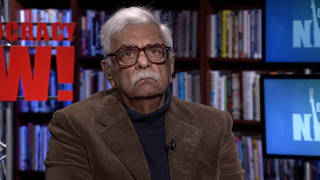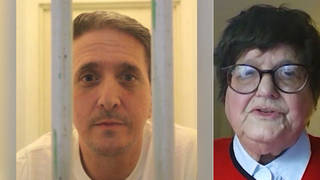
Related
Topics
Guests
- David RoseBritish journalist and author of the The Big Eddy Club: The Stocking Stranglings and Southern Justice.
In 1986 Gary was convicted and sentenced to death for three murders despite no physical evidence that tied him to the crimes. Last week a federal judge upheld his conviction despite new evidence that casts doubt on his conviction. David Rose examines Gary’s case in his new book “The Big Eddy Club: The Stocking Stranglings and Southern Justice.” [includes rush transcript]
Transcript
AMY GOODMAN: A man who has been sitting on death row for over two decades was denied a new trial last week in a highly publicized and controversial case known as “the Stocking Stranglings.” The case dates back to the late 1970s. A serial killer in Columbus, Georgia, raped and murdered several elderly white women by strangling them in their beds.
In 1986, eight years after the last murder, an African-American man, Carlton Gary, was convicted and sentenced to death for three of the murders. No physical evidence was ever produced to tie him to the crimes. Gary has been on death row ever since.
In 2005, a new piece of evidence that had been missing for 20 years — a bite-mark mold taken from the last victim — was presented. Gary’s attorney argued that the mold did not match his teeth, and it was evidence that pointed to his client’s innocence. But last Wednesday, U.S. District Court Judge Clay Land ruled the mold doesn’t cast enough doubt on Gary’s case to undermine the '86 conviction. Carlton Gary's case now goes to the 11th Circuit Court of Appeals in Atlanta.
Award-winning journalist David Rose has followed this case for more than 10 years and just published the book, The Big Eddy Club: The Stocking Stranglings and Southern Justice. David Rose is a contributing editor at Vanity Fair and has worked for The Guardian, The Observer and the BBC. He’s the author of five previous books, including Guantanamo. David Rose joined me in the firehouse studio last week just two days before Judge Land’s latest ruling on the bite-mark mold to talk about the case and the significance of this piece of evidence.
DAVID ROSE: Right now, the case is at an absolutely critical stage. Perhaps the most important piece of evidence that I’ve dug up is a bite cast made from the killer’s teeth. The story behind this is extraordinary. At the trial, the defense attorney, Bud Siemon, who had no money, could see from the photo of one of the victims, Janet Cofer, that she had been bitten savagely by the murderer, and there was a very distinctive pattern of tooth marks on her breast. And so, he asked the judge, “Can we get an expert to compare this photo with Carlton Gary’s teeth?” because it looked like, you know, these teeth were very jumbled up. And Carlton Gary was a very good-looking guy. Unlike most serial killers, he had a number of successful relationships with women. He had even worked as a model. At the time of these murders, he was appearing five times a night on television modeling clothes. And I’ve always thought that makes him unique among alleged serial killers, that he was actually, you know — it’s very easy to identify someone if you’ve seen him on TV. You don’t have to give a vague description to the cops. You say, “It’s that guy, the guy who’s in those commercials.”
Well, of course, nothing happened with that at the trial, but then, later, in the '90s, the defense attorney who represented him at his state appeal, Jeff Ertel, thought he'd revisit this issue, and he went to Atlanta — or he lived in Atlanta — he found that in Atlanta was an expert in the field of forensic odontology called Thomas David, and he might be able to compare the photo with the bite — with Carlton Gary’s bite. And, well, he called Dr. David, and he said, “I know about this case. Come and see me straightaway.”
And it turned out that Ricky Boren, the former chief detective of Columbus, now the chief of police; the district attorney, Bill Smith, at the time, and his assistant Doug Pullen — both men now are superior court judges — had come to see him before Carlton Gary’s trial with a cast that had been made by a local dentist of the killer’s teeth. And they said to him, “If this matches our suspect, you know, is this good evidence? Can you testify that this means he’s the killer?” And he said, “Yeah. That’s pretty good. If that matches, you have the right guy.” And then they said — very strange question — they said, “And if it doesn’t match, would you be able to testify that this doesn’t necessarily exclude him?” And he said, “No, no. If that doesn’t match him, you have the wrong man. This would exclude him.” And they said, “Just forget this meeting ever happened. Don’t tell anybody about it.”
Well, years passed, he told the defense. The defense contacted the dentist in Columbus who had made the bite. Very strangely, he told them that the cops had given it back to him. They hadn’t kept it in an exhibit store, this potentially critical piece of evidence. They had given it back to him. And he said, “Well, can I come and see it?” And the dentist, Carlos Galbreath, said, “Sure, come by next week.” Well, Jeff Ertel, the defense lawyer, and a colleague went to see the dentist. And he said, “I’m so sorry. I can’t find it. I think I destroyed it five years ago.” And that seemed to be the end of the matter.
But then, a number of years ago, about 2001, I went to see the dentist. And I said, “Dr. Galbreath, what happened with that bite cast? Why did you destroy it?” And he looked at me, and he said, “I didn’t destroy it. I know it’s still in existence.” And I said, “Well, why did you say you couldn’t find it back in the early ’90s?” And he said, “Well, you see, the district attorney at the time, Doug Pullen, he’s my best buddy. We go bird shooting every Sunday, we have done for the last 30 years.” And he showed me. He had blown the top of three of his fingers off bird shooting with Doug Pullen. And that’s why he had shut down his practice. And he said, “When the defense attorney called me, I called Doug, and I said, 'Doug, what shall I do? This guy wants to come and see the bite cast.'” And Doug, he said, told him, “You tell him any story you want, but don’t let him see that bite cast. Tell him” — a very strange phrase, I don’t know quite what it means — he said, “Tell him his reputation precedes him, and he can’t see the bite cast.”
Astonishingly, he repeated this in an affidavit, and this was filed with the federal court. And then this hunt began for the bite cast. And all kinds of people testified that they couldn’t find it. The dentist said he had given it to the coroner, who had in fact passed away. His family said they couldn’t find it, although they said they remembered seeing it. They said he used to take it out and show visitors and say, “These are the Stocking Strangler’s teeth.” But it was going nowhere.
And then, finally, at the end of 2005, at a point when Carlton Gary’s case had left the district court — it was now in the 11th Circuit, he had lost the first stage of his federal appeal, it wasn’t looking good for him — it was just a few days before he was due in the 11th Circuit Court in Atlanta for what would have been probably his last appeal, suddenly the assistant attorney general of Georgia, Susan Boleyn, who conducts death penalty appeals on behalf of the state, called Carlton Gary’s lawyers and said, “The folks in Columbus have found that bite cast.”
All last year, it was analyzed, and Dr. David, the same expert, photographed it from every which way under a high-resolution microscope. He made a cast of Carlton Gary’s teeth. And finally, on February the 14th of this year, there was an evidentiary hearing in Columbus at which the expert testified that this bite cast excluded him to a level of reasonable scientific certainty. And we’re waiting for the judge.
And there is another aspect to this, which is just extraordinary. In my book, I’ve not just talked about the case. I’ve talked about the whole kind of history of race relations in Columbus, Georgia. And I’ve gone back to even before the Civil War and shown, I think, how that history of violence and racism and oppression has fed into this case. But there is one incredible thread that runs through it, which is the role of a single family, begins with a man called Aaron Brewster Land, who was responsible for two absolutely horrendous lynchings in the early part of the 1900s. We move to his son, John Land. John Land covers up the death of the black civil rights leader in Columbus, Thomas H. Brewer, in 1956, and he then makes the decisions in Carlton Gary’s case, by the time of which, of course, he’s become a judge. He had been the district attorney in '56. He makes the decisions, which deny Carlton Gary funding for his trial. And now it's his great-nephew who is the federal judge, who holds Carlton Gary’s fate in his hand. It’s Judge Clay Land of the federal court of Columbus who now has to decide whether to give him a new trial. So there’s this extraordinary continuity of more than a century, and this one family kind of represents this. And it’s down to Clay Land to decide whether to do the right thing.
AMY GOODMAN: David Rose, investigative reporter, author of The Big Eddy Club. We’ll come back to him in a minute.
[break]
AMY GOODMAN: We return to our conversation with the award-winning Vanity Fair reporter, David Rose, about his new book, The Big Eddy Club: The Stocking Stranglings and Southern Justice, about the death row case of Carlton Gary. I asked David to go back to the ’70s and lay out the story.
DAVID ROSE: Well, the Stocking Stranglings was a serial killing spree in the late 1970s in eight months in Columbus, Georgia, a very conservative city in the Deep South, about a hundred miles south of Atlanta. Seven elderly, mainly rich, white women, who lived alone, were brutally raped and strangled, mostly with their own stockings, by a serial killer, whom the police seemed completely unable to apprehend. He seemed to be able to rampage through an upscale white neighborhood known as Wynnton with complete impunity. And for many years, the police had no really viable suspects, until finally in 1984 they arrested a guy called Carlton Gary, who was no poster boy. He, by his own admission, had a criminal record of some length, but he had always maintained he had never committed any violent crimes. And in 1986 he was convicted and sentenced to death, and he’s on death row now, 21 years later.
AMY GOODMAN: How was he picked up?
DAVID ROSE: Well, that is a very interesting and complicated process. But the cop who probably can claim to have solved the crime more than anybody else, a man called Detective Michael Sellers, looked me in the eye in a hotel in Gwinnett County, north of Atlanta, and said that his investigation began with a phone call from God.
The simple answer is there is no clear reason why they picked on him as a suspect, other than the fact that he had been involved in a crime in Albany, New York, in upstate New York in 1970, where an elderly woman was raped and strangled, although he had always maintained that he had not committed this crime, that he had only acted as the lookout. Indeed, he wasn’t charged with this murder; another guy was.
When he came to his trial in Columbus, Georgia, the district attorney there, Bill Smith, said that in fact he had committed this murder, although he couldn’t produce any evidence that this was in fact the case. I’ve since found evidence to show that it’s quite clear that he didn’t, in the form of footprints that the killer left in the murdered woman’s apartment and forensic tests that were done on those footprints by the scientists in New York in 1970. And what they showed is that the killer there had size 9.5 shoes, whereas Carlton Gary has size 13.5 or 14 shoes. He has unusually large feet. So there’s good reason to suppose that he didn’t do that murder, but belief that he had was really why Columbus Police Department made him a suspect. And then there was, as I say, this mysterious phone call from God to the detective, which put him on the scent.
AMY GOODMAN: Talk more about how they picked Carlton Gary up, what role he played in the community. And then talk about the community and the response and how the investigation went on for eight years.
DAVID ROSE: Well, Carlton Gary was born in Columbus, and he lived there ’til he was 13 years old, and then his mother moved to Florida, and so he left the city. He had a pretty itinerant lifestyle in his late teens. He was a musician for a time. He was working in a variety of jobs in upstate New York and other places in the sort of Northeast. And he also was committing crimes. He was, as I say, convicted of this robbery, as being an accomplice of the killer in Albany, and he went to prison for about five years for that. But he made his way back to Columbus, Georgia, in the early fall of 1977 and just before, or maybe just after, the Stocking Strangling murders began.
Now, he continued to live in Columbus for about a year after they finished. There’s a myth that’s very widespread down there, which says, oh, well, the murders began when he moved back to Columbus, and they stopped when he left. In fact, that’s not true. He was living in Columbus for longer after the murders ended than the entire period of the murders.
But in 1979, in the spring of 1979, he was arrested in South Carolina trying to rob a fast-food restaurant in a rather inept fashion. He held a gun to the cashier, and she said, “I don’t believe that gun’s loaded,” which indeed it wasn’t. Then he ran out the back into a swamp and was arrested in rather deep water by the police. And I think he was worried that an alligator might be about to eat him.
So, you know, he looked like a plausible suspect. I think what probably happened is that the South Carolina authorities, when he left prison in 1984, before his arrest, told the Columbus Police Department that he might be headed their way, as indeed he was. And I think what probably happened is that this detective thought, “Hmmm, look at his record. Maybe he’s the Stocking Strangler murderer.”
But what is very much the case, of course, is that these murders were the most enormous blow to the community of Columbus. They were happening in an all-white upscale neighborhood, and the police seemed completely unable to do anything to prevent them from happening. And there was really a reign of terror for the period of those killings. The area was swamped with cops, with state troopers, with soldiers from Fort Benning, the nearby military base, and, as I say, nothing seemed to be able to stop this guy from killing.
I think there’s a real possibility that the killer was actually white, because this is an all-white neighborhood. I think any African American insinuating himself into that neighborhood at night and trying to break into women’s homes would have been easily apprehended, whereas they weren’t looking for a white person. Incidentally, the reason they believed that the killer was black was because the local coroner, who actually had no training as a mortician — sorry, he had training as a mortician, but not as a doctor, as a pathologist, any kind of forensic scientist — but he told the cops that pubic hairs found at the crime scenes displayed what he called “Negroid characteristics,” by which he meant they were black and curly, and perhaps he had never seen a white person with black and curly pubic hair.
But in any event, the police were convinced that the killer was black. And, of course, in the Deep South, especially in the 1970s, I mean, this added an enormous charge. The fact that an African American was violating vulnerable, elderly white women, the racial dimension to that gave these crimes an even greater impact.
AMY GOODMAN: Criticism of you in the Ledger-Enquirer in Columbus, the author talks about how, for a couple hundred pages, you didn’t say you were a paralegal in this case. Talk about your access to this case — were you a paralegal? — and your interviews with Carlton Gary.
DAVID ROSE: Well, for a long time, I got drawn into this slowly from about 1996. And as soon as I looked at this case, I thought it just stank. I had actually gone to Georgia initially to write an article for a British newspaper about the death penalty. And I went to Columbus, because Columbus had sent more people to death row than anywhere else in Georgia and indeed, per capita, may well have sent more people to death row than anywhere else in the United States.
And, you know, I had begun to find out about the case, and all kinds of things intrigued me. One of the most extraordinary things is that the defense had absolutely no money. They had no funding at all, by which to defend Carlton Gary. And, of course, this was a very complex case with all kinds of scientific evidence that has turned out to be extremely questionable. But a senior judge, the chief judge at the circuit, a guy called John Land, who had a very interesting family background, had made decisions which meant he had no funding.
And so, as I started gradually to get drawn in — I went to visit Carlton many times; I mean, I think I’ve seen him 10 times now — I began to dig up evidence that further undermined the prosecution’s case, which — beyond what had already come out at his state appeals. He was now in the federal court in his federal habeas corpus appeal. And I felt that if I was coming up with evidence that could exonerate this man, I had a simple moral duty to share it with the defense. It would be wrong to stack up evidence over perhaps a period of years, as indeed turned out to be the case. I was working on this for about nine years, which were then —- if I didn’t give it to the lawyers, they might miss a filing deadline. He could literally be executed on a technicality, in a sense. There could be evidence out there, which might well have got him a new trial, but he wouldn’t get one, because his lawyers had not filed it in time. So I said, “Look, I’m basically working as an investigator here. Why don’t you make me officially a paralegal investigator?” And I’ve been completely transparent about this. Well, OK, I mentioned it on page 200, but that’s just where it happens in the narrative. And, you know -—
AMY GOODMAN: It also gave you access to Carlton Gary.
DAVID ROSE: Well, it gave me much better access to him. It meant that when I went in to see — I mean, you can go into death row as a friend, as a visitor, but you can’t take any notes. So, you know, I would go in and see him, and he would pour out this story, tumbling out, desperate to tell me about his life. I’d just be trying to remember it, and I’d get out into the parking lot, and I’d be scribbling notes. Once I was going in as a paralegal, I could take in documents, he could give me documents, and I could take notes. And I could do other things. On one occasion, I smuggled out his semen from death row.
AMY GOODMAN: How did you do this?
DAVID ROSE: Well, I gave him an envelope and a piece of paper and some cling wrap, and I said, “I’m going out for lunch. I’ll come back this afternoon. You produce a semen sample in your cell, and I’ll collect it later.” And then, when I did that, I gave him another envelope, and I said, “Pluck some hairs from your head in front of me, so I can then do a DNA cross match between the hairs — the hair roots and the semen, prove it’s your semen, and then we can test the semen.”
Now, I should say, we couldn’t do a DNA test. We couldn’t just, you know, send off his semen and compare it with the crime scene samples, because the state claimed — and indeed the former district attorney of Columbus, now a superior court judge, Doug Pullen, actually testified in his state appeal — that the semen samples from the crime scenes had been destroyed, because they were, as he put it, a biohazard.
But what you could do was another kind of testing. In the 1970s, when these crimes happened, they did this thing called serology typing. Most people are what are called secreters. That means that in their other bodily fluids, such as semen or saliva, they excrete or secrete the blood group chemical, the antigen that defines you as blood group O, blood group A, and so forth. And it was quite clear from the tests that the killer was a non-secreter. They had tested Carlton Gary’s saliva when they arrested him, and he, equally clearly, was a blood group O secreter.
Well, the state’s expert at the trial said, “Well, maybe he just changed over time, or maybe he was a secreter in his saliva but not his semen.” And, of course, the defense, which had no money at the trial, couldn’t challenge this. They couldn’t call an expert to delve into this deeper. And, in fact, you read the transcript, they’re begging the judge for funds, and he won’t give it to them. So the state was still sticking to this position in the federal court. And so, I conducted this test to see if he really was a secreter in his semen, and, of course, he was actually found to be secreting about 10,000 as much of the chemical as the killer was.
AMY GOODMAN: We’re talking to David Rose, author of The Big Eddy Club: The Stocking Stranglings and Southern Justice. David is a contributing editor at Vanity Fair and has worked at various British papers, The Guardian, The Observer, worked also with the BBC. Well, the title of your book is The Big Eddy Club. Talk about the Big Eddy Club.
DAVID ROSE: Well, the Big Eddy Club is a venerable institution for Columbus’s elite. It stands in a beautiful location on the Chattahoochee River, a promontory between the main river, which is dammed at that point, and a tributary, Standing Boy Creek. It was founded by a wealthy industrialist in 1920 to provide a retreat for Columbus’s richest families. And Columbus is a very wealthy place; it always has been. It’s, you know, the place where Coca-Cola was financed. It’s the home of AFLAC, the huge insurance company, of the CB&T Bank, of other big corporations.
And the Big Eddy Club, until 2006, was an all-white institution. And five of the victims of these murders were either members of the club or very regular visitors, as were all the senior white officials who were involved in prosecuting and trying Carlton Gary. And so, although I’m not suggesting that the club actually has a sort of functional role in the case, it’s kind of symbolic of the way that things have been done in Columbus for a very long time. And also the fact that it has now admitted an African-American member, I think, is also evidence that Columbus, like many places in the South, is now beginning to change. In fact, arguably, I think, the criminal justice system there is one of the most resilient bastions of kind of old South values. It’s most resistant to try to, well, perhaps come into the 21st century. But the club, you know, it’s a place where people mingle and network. And you have to wonder whether, you know, the fact that these women were members of the club and the officials who prosecuted Carlton Gary were, too, if that added yet another edge to the way that they prosecuted the case.
AMY GOODMAN: Award-winning Vanity Fair reporter David Rose, talking about the Carlton Gary case, his new book, The Big Eddy Club: The Stocking Stranglings and Southern Justice. And we’ll continue to follow that case.












Media Options